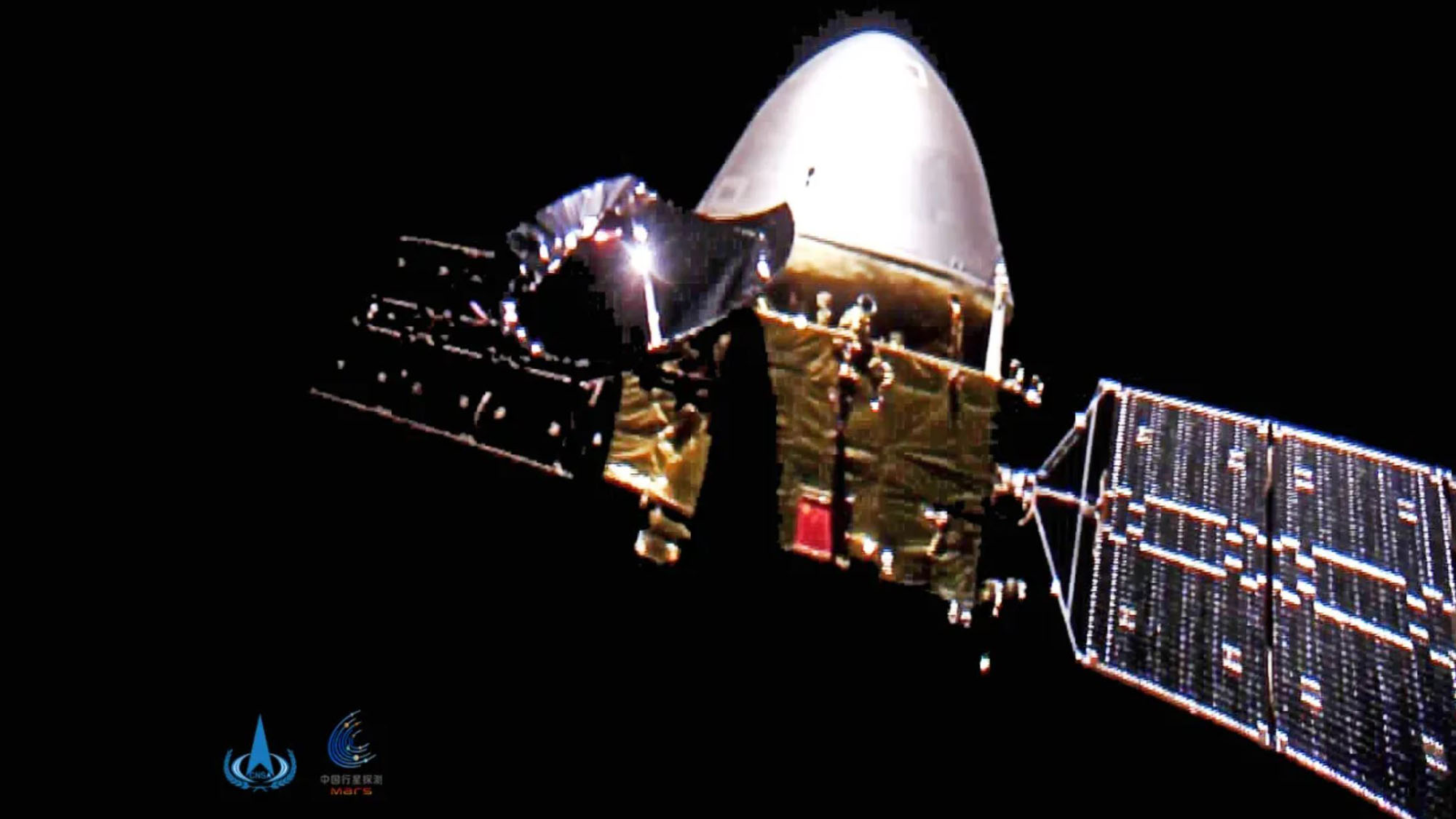Mars madness! China, UAE to reach the Red Planet this week ahead of epic NASA rover landing
February is the month of Mars!

Mars missions from China and the United Arab Emirates arrive in orbit around the Red Planet this week, followed by the landing of NASA's Mars rover Perseverance next week.
The UAE's Hope orbiter is set to arrive at the Red Planet on Tuesday, with China's Tianwen-1 mission following less than a day later. Here's what to expect and how to watch or follow live.
The Emirates Mars Mission, also known as Hope, is the Gulf state's first interplanetary mission. Launched in July 2020, the Hope orbiter is the first of three spacecraft currently homing in on Mars after journeys of more than 250 million miles (400 million kilometers).
Related: NASA's Mars rover Perseverance in home stretch to the Red Planet
Book of Mars: $22.99 at Magazines Direct
Within 148 pages, explore the mysteries of Mars. With the latest generation of rovers, landers and orbiters heading to the Red Planet, we're discovering even more of this world's secrets than ever before. Find out about its landscape and formation, discover the truth about water on Mars and the search for life, and explore the possibility that the fourth rock from the sun may one day be our next home.
The action will begin Tuesday, Feb. 9, at 10:30 a.m. EST (1530 GMT, 7.30 p.m. local time at the UAE Space Agency headquarters in Abu Dhabi). At that time, Hope will burn its engines for 27 minutes to reduce its speed from over 75,000 mph (121,000 kph) to about 11,200 mph (18,000 kph), slow enough for Mars to gravitationally capture Hope.
The UAE Space Agency is providing a webcast for live coverage of the historic event. A live tracker also gives information and a sense of perspective for the 200-day-plus journey to the Red Planet.
The stakes will be high for the $200 million mission. If the maneuver does not go according to plan the spacecraft might not enter orbit. The Soviet Union's 1973 Mars 4 mission failed to enter orbit due to engine problems and carried on past the planet, while NASA's 1999 Mars Climate Orbiter mission burned up in the atmosphere after getting too close to Mars during its orbit insertion attempt.
Get the Space.com Newsletter
Breaking space news, the latest updates on rocket launches, skywatching events and more!
Related: The United Arab Emirates' Hope mission to Mars in photos

Despite the dangers there is excitement and optimism among those behind the mission, and an understanding of the exceptional event in which Hope is participating.
"For the first time, three spacecraft from three different nations are arriving to Mars a couple of days apart and that, for me, is remarkable," Sarah Al Amiri, chairperson of the UAE Space Agency, said during a virtual event hosted on Feb. 1 by the U.S.-UAE Business Council, a nonprofit organization based in Washington.
If it enters orbit successfully Hope will begin science observations to provide new insights into the Martian atmosphere and weather.
China's Tianwen-1 arrives
Following Hope is China's Tianwen-1 orbiter and rover, which will make their own orbit insertion attempt less than a day later.
This is China's first independent interplanetary mission and represents a big step in the country's ambitions and capabilities. Following Tianwen-1's orbit insertion attempt from home will be more challenging however.
China has provided numerous updates on the progress and status of the mission and on Friday (Feb. 5) released an impressive image of Mars from 1.36 million miles (2.2 million km) away.
However, China mostly does not publicize major mission timelines ahead of time. The country's space authorities offer no live tracking and, as with China's previous major missions, a webcast will only be available a few hours before the event or, more likely, not at all. The CGTN YouTube channel is one possibility in the event that a webcast is offered, as is the Chinese language CCTV account on Sina Weibo.
Despite this we have a good idea of when the spacecraft is due to make its own Mars orbit insertion attempt.
By picking up signals sent between Tianwen-1 and Chinese ground stations amateur radio operators are able to determine information about the spacecraft's speed and position and calculate the arrival time at Mars.
Daniel Estévez, an amateur radio operator who tracks spacecraft together with fellow enthusiasts, calculates that Mars orbit insertion around 7 a.m. EST (1200 GMT, 8 p.m. Beijing time) on Wednesday (Feb. 10), meaning Tianwen-1's braking burn will begin up to half an hour before this. As with the Hope orbiter, Tianwen-1 will need a long burn of its main engines to slow the spacecraft enough to allow it to be captured by Mars's gravity. The main engines were tested through smaller maneuvers on the way to Mars.

An update is expected to follow from the China National Space Administration and Chinese media after the maneuver if the spacecraft successfully enters orbit. Due to temporary signal losses and a communications delay of about 11 minutes between Earth and Mars, we may not find out if Tianwen-1 successfully entered Mars orbit until up to an hour after the maneuver takes place.
Tianwen-1 is expected to go into a highly elliptical orbit — an elongated, oval-shaped orbit rather than a circular one — which will see the spacecraft approach as close as a few hundred miles away from Mars out to about 112,000 miles (180,000 km) away.
The orbiter will alter its orbit over time, reducing its furthest distance from Mars during separate observation and science orbit phases.
The spacecraft will also prepare for the landing attempt of the mission's rover, currently expected to follow in May.
Before then NASA's Perseverance rover is expected to arrive at Mars for its landing attempt on Feb. 18.
Follow us on Twitter @Spacedotcom and on Facebook.
Join our Space Forums to keep talking space on the latest missions, night sky and more! And if you have a news tip, correction or comment, let us know at: community@space.com.

Andrew is a freelance space journalist with a focus on reporting on China's rapidly growing space sector. He began writing for Space.com in 2019 and writes for SpaceNews, IEEE Spectrum, National Geographic, Sky & Telescope, New Scientist and others. Andrew first caught the space bug when, as a youngster, he saw Voyager images of other worlds in our solar system for the first time. Away from space, Andrew enjoys trail running in the forests of Finland. You can follow him on Twitter @AJ_FI.










